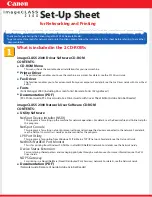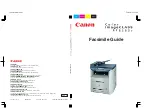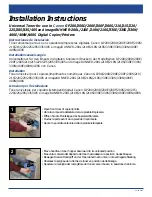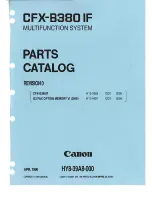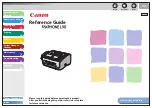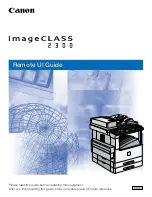
Chapter 7
7-11
The AC and DC biases thus generated are combined at such times as specified for application to the developing cylinder.
The level of the developing bias varies in keeping with the instructions from the DC controller.
7.2.4 Generation of the Primary Transfer Bias
0013-8477
/ / / / iR C3380i / iR C3380 / iR C2880i / iR C2880
The primary transfer bias is used to transfer toner from the surface of the photosensitive drum to the ITB.
The bias is generated by the primary transfer DC high-voltage generation circuit of HVT2. The circuit is used to provide a DC bias for application to the primary
transfer roller, producing 4 independent biases for individual colors (TR1_Y, TR1_M, TR1_C, TR1_Bk). These DC biases are applied to the primary transfer roller
at such times as specified.
The level of the primary transfer bias varies according to the instructions from the DC controller.
The DC controller, on the other hand, switches the voltage level of the primary transfer bias for constant voltage control according to the primary transfer current
feedback signal (TR1S) arriving from the primary transfer high-voltage generation circuit.
7.2.5 Generation of the Secondary Transfer Bias
0013-8478
/ / / / iR C3380i / iR C3380 / iR C2880i / iR C2880
The secondary transfer bias is used to transfer toner from the ITB to paper.
The bias may be either DC positive bias or DC negative bias generated by the DC high-voltage generation circuit of HVT2. The DC positive bias is applied to the
secondary transfer roller at time of toner transfer, while the DC negative bias is applied to the secondary transfer roller at time of cleaning.
The high-voltage power supply circuit applies these secondary transfer biases (TR2) to the secondary transfer roller in keeping with a specific printing sequence as
follows:
- Print Bias (DC positive bias)
It is a bias used to transfer toner from the ITB to paper as part of printing sequence. It is a DC positive bias and is applied to the secondary transfer roller.
- Sheet-to-Sheet Bias (DC negative bias)
It is a bias used to return the residual toner from the secondary transfer roller to the ITB after forming a patch image or between sheets during continuous printing.
The machine applies both DC positive and negative biases to the secondary transfer roller in turns.
- Cleaning bias (DC positive /DC negative bias):
It is a bias used to return the toner sticking to the secondary transfer roller after the formation of a patch image or at power-on. It actually consists of a DC positive
bias and a DC negative bias applied alternately to the secondary transfer roller.
The level of the secondary transfer bias varies in keeping with the instructions from the DC controller.
The DC controller, on the other hand, switches the level of the secondary transfer bias in keeping with the secondary transfer current feedback signal (TR2S) arriving
from the secondary transfer DC high-voltage generation circuit for constant voltage control.
7.3 Image Stabilization Control
7.3.1 Overview of Image Stabilization
0013-8481
/ / / / iR C3380i / iR C3380 / iR C2880i / iR C2880
To ensure an ideal image against the deterioration of parts associated with imaging otherwise occurring as a result of changes in the environment or in the machine,
the following mechanisms are used:
F-7-16
T-7-10
Item
Description
[1]Drum film thickness detection
computes the film thickness of the photosensitive drum
[2]ATR control
determines the amount of toner to supply
Y
M
C
BK
[3]
[4]
[8]
[9]
[1]
[5]
[7]
[6]
[2]
UN16
UN15
D-CON
Laser
Scanner
Unit
M-CON
Summary of Contents for iR C3380 series
Page 1: ...Aug 29 2006 Service Manual iR C3380 2880 Series...
Page 2: ......
Page 6: ......
Page 23: ...Chapter 1 Introduction...
Page 24: ......
Page 26: ......
Page 52: ......
Page 53: ...Chapter 2 Installation...
Page 54: ......
Page 127: ...Chapter 3 Basic Operation...
Page 128: ......
Page 130: ......
Page 136: ......
Page 137: ...Chapter 4 Main Controller...
Page 138: ......
Page 160: ......
Page 161: ...Chapter 5 Original Exposure System...
Page 162: ......
Page 188: ...Chapter 5 5 24 F 5 68 4 Remove the original sensor 2 hook 1 F 5 69...
Page 189: ...Chapter 6 Laser Exposure...
Page 190: ......
Page 192: ......
Page 206: ......
Page 207: ...Chapter 7 Image Formation...
Page 208: ......
Page 256: ......
Page 257: ...Chapter 8 Pickup Feeding System...
Page 258: ......
Page 262: ......
Page 303: ...Chapter 9 Fixing System...
Page 304: ......
Page 306: ......
Page 321: ...Chapter 10 Externals and Controls...
Page 322: ......
Page 326: ......
Page 336: ...Chapter 10 10 10 F 10 10 2 Remove the check mark from SNMP Status Enabled...
Page 337: ...Chapter 10 10 11 F 10 11...
Page 359: ...Chapter 11 MEAP...
Page 360: ......
Page 362: ......
Page 401: ...Chapter 12 RDS...
Page 402: ......
Page 404: ......
Page 411: ...Chapter 13 Maintenance and Inspection...
Page 412: ......
Page 414: ......
Page 416: ...Chapter 13 13 2 F 13 1 8 9 1 2 3 3 5 6 7 10 11 12 13 14 4...
Page 421: ...Chapter 14 Standards and Adjustments...
Page 422: ......
Page 424: ......
Page 431: ...Chapter 15 Correcting Faulty Images...
Page 432: ......
Page 434: ......
Page 459: ...Chapter 16 Self Diagnosis...
Page 460: ......
Page 462: ......
Page 481: ...Chapter 17 Service Mode...
Page 482: ......
Page 484: ......
Page 571: ...Chapter 18 Upgrading...
Page 572: ......
Page 574: ......
Page 603: ...Chapter 19 Service Tools...
Page 604: ......
Page 606: ......
Page 609: ...Aug 29 2006...
Page 610: ......
































